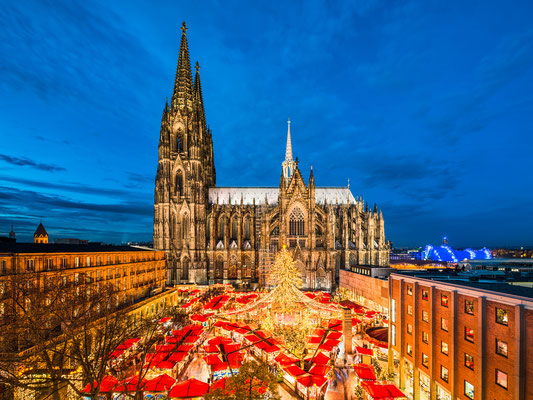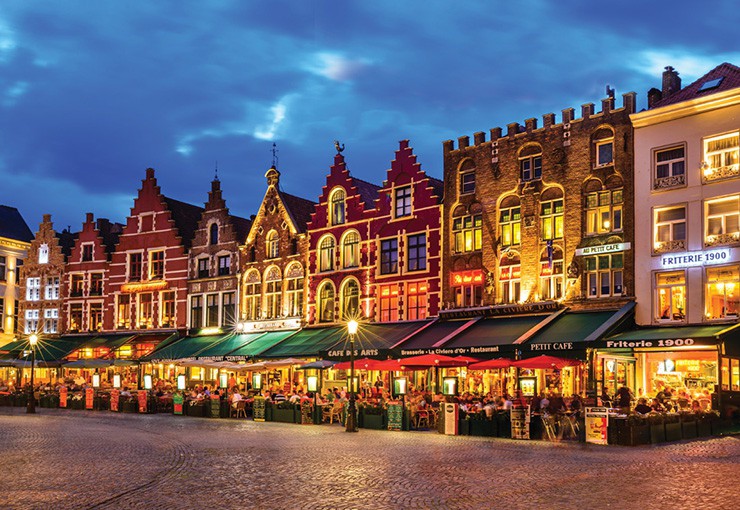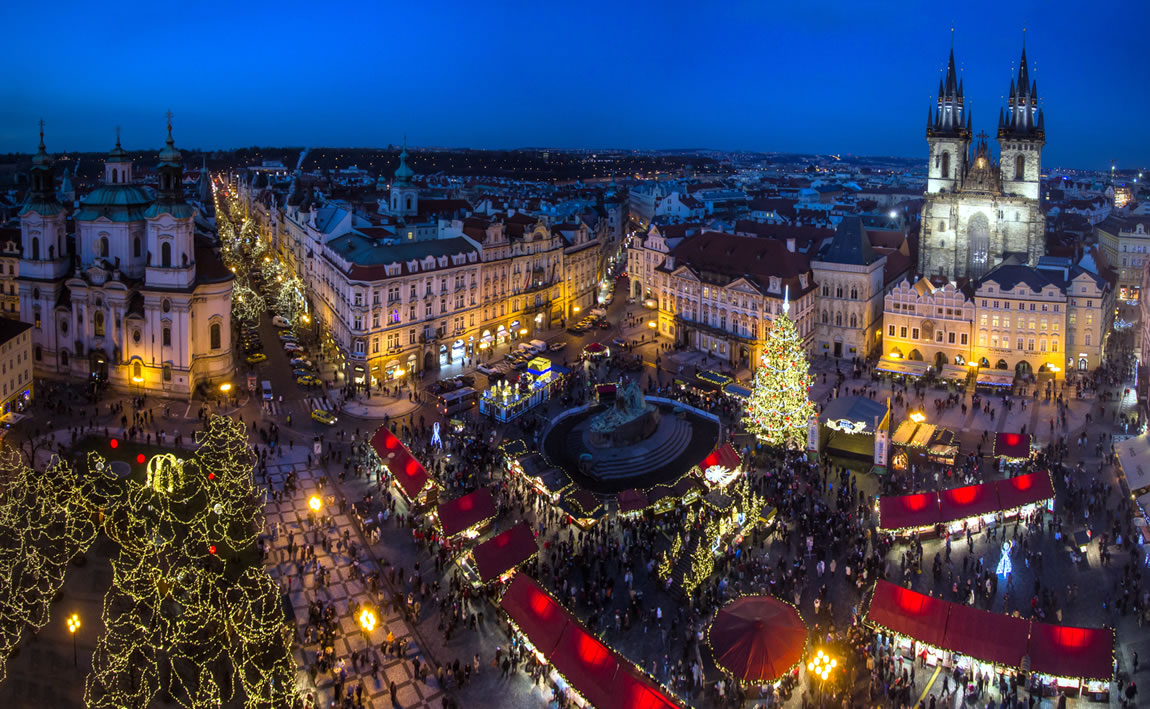Picture the glow of medieval squares illuminated by thousands of sparkling lights. Imagine gingerbread-style stalls where artisans offer traditional crafts that threaten to banish gifts of boring neckties and fruitcakes for eternity. Marvel at iPod-toting children falling under the spell of low-tech charms like wooden toys, ice rinks and vintage merry-go-rounds.
By ditching the mall and making the journey to one of Europe's fabled Christmas markets, you can exchange chain stores for cosy wooden chalets, Muzak for angelic choirs, and consumer frenzy for down-to-earth local holiday cheer. "Going to market" remains one of the best ways to see these five fetching cities truly evoke a bygone era, with old world traditions that go as far back as the Middle Ages:
1. Cologne
 Germany's reputation for legendary Christmas markets is well deserved - and this is the granddaddy of them all. With the dramatic backdrop of the famed Cologne cathedral, the Kölner Dom, casting its magnificent shadows on the festive proceedings, the market at the Domplatz is a good place to start. Next, head to the Medieval Christmas Market, where handcrafts and live music compete with a breathtaking live nativity set for your postmodern attention span.
Germany's reputation for legendary Christmas markets is well deserved - and this is the granddaddy of them all. With the dramatic backdrop of the famed Cologne cathedral, the Kölner Dom, casting its magnificent shadows on the festive proceedings, the market at the Domplatz is a good place to start. Next, head to the Medieval Christmas Market, where handcrafts and live music compete with a breathtaking live nativity set for your postmodern attention span.
When: 22 November to 23 December
What to buy: Räuchermännchen (wooden dolls complete with smoking pipe), nutcrackers, children's toys and well-priced charity products whose proceeds go to the needy.
Food and drink: Wash down aromatic baked apples and roasted almonds with the traditional, cinnamon-infused glühwein. Plus, an eco-friendly, fair trade ethos means that you can conscientiously indulge in organic treats.
For the children: At the Alter Markt you will find a child's winter paradise, complete with a merry-go-round and a puppet theatre. Ice skaters, head to the Heumarkt.
2. Vienna
 Come wintertime, Christmas markets in Vienna become as ubiquitous as the city's elaborate Baroque architecture. You will find the Viennese version of winter wonderland - at once cosy and elegant - coming to life in public squares all over town.
Come wintertime, Christmas markets in Vienna become as ubiquitous as the city's elaborate Baroque architecture. You will find the Viennese version of winter wonderland - at once cosy and elegant - coming to life in public squares all over town.
After stopping by the popular Christkindlmarkt in front of the Rathausplatz, waltz over to the market in front of the lavish Schönbrunn Palace, the former imperial residence. True to Vienna's storied musical heritage, expect plenty of classical concerts fuelling the nonstop city-wide party.
When: mid-November to Christmas Eve
What to buy: Hand-blown glass, jewellery, candles and handmade baby cribs
Food and drink: Key indulgences include apfel strudel, maroni (chestnuts), bratwurst, and lebkuchen (gingerbread). To drink? Glühwein or punsch, natürlich.
For the children: Little ones will go starry-eyed at the market in front of Vienna's neo-Gothic Rauthaus (town hall), which is decorated as a giant Advent calendar. A hands-on Christmas workshop, pony and carousel rides, and a bewitching winter garden also delight.
3. Bruges
 The medieval splendour of this Unesco World Heritage site, full of serene grace and picturesque canals, only intensifies when December rolls around. Do not skip the awe-inducing Snow and Ice Sculpture Festival, held in a massive thermal tent. Two tips: dress warmly and plan to do some serious chilling out with a cocktail in the Ice Bar.
The medieval splendour of this Unesco World Heritage site, full of serene grace and picturesque canals, only intensifies when December rolls around. Do not skip the awe-inducing Snow and Ice Sculpture Festival, held in a massive thermal tent. Two tips: dress warmly and plan to do some serious chilling out with a cocktail in the Ice Bar.
When: 26 November to 2 January
What to buy: A fantastic array of Belgian chocolates, along with ceramics (think beer steins) and cosy handmade clothing.
Food and drink: You are in Belgium: have a beer. Why not try one of the rich ales specially brewed for the holidays?
For the children: Keep shopping-weary kids on their toes at the ice skating rink, held on the Market Square.
4. Strasbourg
 In the heart of Alsace, the German-inflected region of France that is said to be home to the first Christmas tree, this gorgeous market is a classic. Since 1570, the Christkindelsmärik has offered serious holiday enchantments, making it the oldest in France. Stroll from Place Broglie to Place Kléber under the glow of thousands of brilliant lights until you arrive at the festival's focal point: the breathtakingly giant Sapin de Noël, or Christmas tree.
In the heart of Alsace, the German-inflected region of France that is said to be home to the first Christmas tree, this gorgeous market is a classic. Since 1570, the Christkindelsmärik has offered serious holiday enchantments, making it the oldest in France. Stroll from Place Broglie to Place Kléber under the glow of thousands of brilliant lights until you arrive at the festival's focal point: the breathtakingly giant Sapin de Noël, or Christmas tree.
When: 27 November to 31 December
What to buy: For Christmas decorations (Strasbourg's been peddling them since 1600) head to the Place de la Cathédrale. Enticing Alsatian food specialties can be found in Place des Meuniers.
Food and drink: While adults savour vin chaud, kids can sip on warm jus d'orange sweetened with honey. Along with plenty of German-inspired treats, try the bredele (Alsatian butter cookies in toothsome flavours like ginger and anise) and maennele, or little brioche men.
For the children: Picture a kiddie paradise: puppet shows, visits by Saint Nicholas, spirited games, ice skating, a crèche vivante (living nativity scene) and even an ice garden with an obstacle course.
5. Prague
 As snow dusts its gothic spires and its fabled Astronomical Clock chimes in the chilly air, Prague's cityscape transforms into a gothic midwinter fairy tale. While Staroměstské náměstí, or Old Town Square, is always one of the most stunning in Europe, during Christmas it is downright ethereal. Set against the evocative skyline, the towering Christmas tree - imported each year from the Krkonose Mountains in the North -conjures an enchanting Bohemian vibe.
As snow dusts its gothic spires and its fabled Astronomical Clock chimes in the chilly air, Prague's cityscape transforms into a gothic midwinter fairy tale. While Staroměstské náměstí, or Old Town Square, is always one of the most stunning in Europe, during Christmas it is downright ethereal. Set against the evocative skyline, the towering Christmas tree - imported each year from the Krkonose Mountains in the North -conjures an enchanting Bohemian vibe.
When: 27 November to 2 January
What to buy: Hand-carved puppets and wooden toys, Bohemian crystal, Czech glass, and ornate ceramic mugs. Or why not buy a live carp - sold in tubs lining the streets - to cook up a traditional Czech Christmas dinner?
Food and drink: Grab a traditional fried-dough, cinnamon sugar trdlo washed down with svařené víno (mulled wine) or medovina (honey liquor). Want to ward off the cold with the hard stuff? Many Czechs swear that a shot of the traditional, warmly-spiced liquor Becherovka tastes like Christmas itself.
For the children: Handmade Czech puppets never fail to elicit wonder in even shopping-weary children. Check out the petting zoo and the open-air stage, where children from around the Czech Republic sing and dance in traditional dress with inimitable holiday cheer.
By Sarah Chandler, Lonely Planet